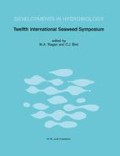Abstract
Lüderitz is situated on the southwest coast of Africa, about 15° longitude and 27° latitude, on the Atlantic coast of the Namib Desert (Fig. 1). The red seaweed Gracilaria verrucosa (Simons, 1976) grows in the areas known as Lüderitz Harbour and Robert Harbour — two sandy lagoons in a larger bay system. These seaweeds have been collected in a very sporadic manner since 1950 (Isaac, 1964). Only since 1975 (Rotmann, 1985) have more organized methods for the production of G. verrucosa been used, and only since 1981 has an intense effort been made to transform the collection into a well- organized operation.
Access this chapter
Tax calculation will be finalised at checkout
Purchases are for personal use only
Preview
Unable to display preview. Download preview PDF.
References
Branch, M. & G. Branch, 1981. The Living Shores of Southern Africa. C. Struik, Cape Town: 78–80.
Chaston, I., 1983. Marketing in Fisheries and Aquaculture. Fish-ing News Books Ltd, Farnham (UK), 15 pp.
Chen, T. P., 1976. Aquaculture Practices in Taiwan. Page Bros, Norwich, 145 pp.
Edwards, P. & D. M. Tam, 1984. The potential for Gracilaria farming in Thailand. Proc. int. Seaweed Symp. 11: 246–248.
Heinichen, E. & E. D. Seipold, 1971. The Preparation of Agar and Agarose from South African Seaweed. Chem. Eng. Group, C.S. I. R., Pretoria.
International Trade Centre UNCTAD/GATT, 1981. Pilot Survey of the World Seaweed Industry and Trade. Geneva.
Isaac, W. E., 1964. Seaweeds of possible economic importance in the Union of South Africa. J. South Afr. Bot. 8: 225–236.
McHugh, D. J., 1984. Marine phycoculture and its impact on the seaweed colloid industry. Proc. int. Seaweed Symp. 11: 351–354.
Rotmann, K. W., 1985. A strategic plan for the establishment of an integrated seaweed industry in southern Africa. Dissertation, Faculty of Commerce, University of the Witwatersrand, Johannesburg.
Shang, Y. C., 1976. Economic aspects of Gracilaria culture in Taiwan. Aquaculture 8: 1–7.
Simons, R. H., 1976. Seaweeds of Southern Africa: Guideline for their Study and Identification. Sea Fisheries Branch, Cape Town.
Author information
Authors and Affiliations
Editor information
Editors and Affiliations
Rights and permissions
Copyright information
© 1987 Dr W. Junk Publishers, Dordrecht
About this paper
Cite this paper
Rotmann, K.W.G. (1987). The collection, utilization and potential farming of red seaweeds in Namibia. In: Ragan, M.A., Bird, C.J. (eds) Twelfth International Seaweed Symposium. Developments in Hydrobiology, vol 41. Springer, Dordrecht. https://doi.org/10.1007/978-94-009-4057-4_45
Download citation
DOI: https://doi.org/10.1007/978-94-009-4057-4_45
Publisher Name: Springer, Dordrecht
Print ISBN: 978-94-010-8301-0
Online ISBN: 978-94-009-4057-4
eBook Packages: Springer Book Archive

